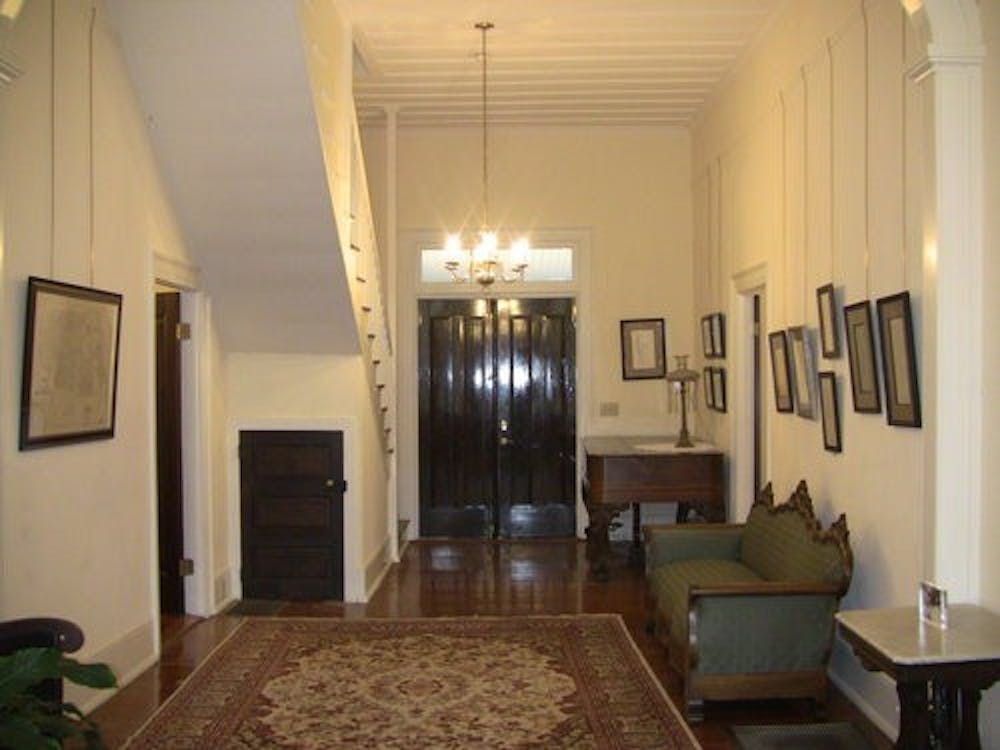A piece of Auburn history sits at the end of East Magnolia.
The Scott-Yarbrough house, more commonly known as “Pebble Hill,” is a large plantation home built in 1847.
Pebble Hill sits approximately 40 yards from Debardeleben Street, which runs north to south. The building is painted white except for the stairs, which are a steel gray color that lead up in both directions toward a heavy wooden door.
The building has obviously been restored, but the integrity of the original building is still intact.
Nathaniel Scott and his wife, Mary, came to East Alabama in the 1830s. They moved onto land recently acquired by the United States from the Creek Indians.
Evelyn Causey, a historian who was hired by Auburn University to research the history of Pebble Hill, said Scott built the house to show his importance to the city.
“The reason he built the house is kind of two-fold,” Causey said. “He wants to be where the activity is, he is developing a career in politics and he wants to be close to the town. But, at the same time, this house is a statement to the people of Auburn. He wants them to know that he and his family are important.”
The Scott family, along with another group of Methodist settlers, helped found what is modern day Auburn.
The Scott family was always supportive of education. At various times, Pebble Hill housed students that were attending schools in Auburn.
After the emancipation of slaves, Mary Scott was forced to sell Pebble Hill after the death of her husband. She sold it to a woman named Mary Riley.
Causey said Riley’s history is unclear.
“She’s kind of a curious character because she’s a widow, she has two children and I have not been able to find any record of her husband,” Causey said. “It’s not clear from the census records what her occupation was, how she brought in an income or how she was able to purchase this house.”
Causey said Riley lived at the house until her death, and then several years later the house was bought by Cecil and Bertha Mae Yarbrough.
Cecil, a physician, moved to Auburn and set up a medical practice.
Cecil was a prominent figure in Auburn at the time, serving multiple terms as mayor and a term for the House of Representatives.
He died in 1946 and, after the death of his second wife in 1967, the house was passed on to his son, Clarke S. Yarborough, where the house remained until 1982.
The house was later donated to Auburn University, and the Center for the Arts and Humanities was founded.
“The center was named in 2007 after Caroline Marshall Draughon,” said Maiben Beard, outreach associate for the Center for the Arts and Humanities. “She was Dr. Ralph Draughon’s wife and an historian. She had a real love of history and a real love of Auburn, so it’s very appropriate that we are named after her.”
Beard, a graduate student in public history, said it was her own love of history that drew her to work at Pebble Hill.
“I grew up in and around Auburn, and this was always one of those places you would drive by and think, ‘that’d be a really cool place to work,’” Beard said.
Beard said she handles the publicity and website for the Center for the Arts and Humanities, and she also coordinates some of the events.
While it has gone through countless restorations already, the Scott-Yarbrough house still has work to be done before it can be fully utilized by the Center for the Arts and Humanities.
“This building is in transition right now,” said Mark Wilson coordinator of community and civic engagement for Auburn University. “Right now it is being used as offices. It’s not used for public programming right now, but it has been in the past and in the future it will be.”
Wilson said a renovation and addition will be started in February that will allow them to use the building for events.
“We’ll break ground and build an office building, and then this will be opened back up for the public,” Wilson said.
Wilson said the house would be used to give people a glimpse into what a 19th-century house looks like and also what it was used for.
“We want the house to be used for functions, but more importantly we want it to be able to interpret the 1840s to the public,” Wilson said.
The high ceilings and wooden floors allow for thundering acoustics throughout this historic landmark.
The paint, art and furnishings have all remained true to the time period.
Beard said this has all been a collaborative effort by the Center for the Arts and Humanities to retain Pebble Hill’s history.
“The house itself has gone through a lot of transformations,” Beard said. “We actually had a guy come who was a paint analyst who does this kind of work on historic buildings. He took samples of all the walls, ceilings and mantles, and he could tell sort of what was here in 1847 and what was added on.”
Causey, who did extensive research on Pebble Hill, said she felt like this was an important part of Auburn’s history that needed to be shared with the public.
“I feel like it’s very hard to see the town’s early history separate from the university,” Causey said. “Pebble Hill is a very well preserved pre-Civil War building, and it’s a great way to see and understand the history of this town.”
Beard said the programs offered by the Center for the Arts and Humanities is something that will always be needed.
“We’ve lost a lot of older homes in Auburn to development, so it’s sort of nice to have this piece of Auburn history,” Beard said. “If you look at the history of the house and the change of landscape around it, then you really get a sense of the history of Auburn.”
Wilson said that in order to think about the future of a community, then you have to first learn from its past.
“There’s a sense of dignity that comes to a community when it preserves its past,” Wilson said. “In a sense we are looking forward to future generations being able to enjoy all of what this house has to offer, but it’s also about the past, honoring all of the people who have cared for this home, bringing it full circle and doing justice to one of these historical treasures.”
A slideshow presentation is available here.
To view the accompanying multimedia presentation, click here.
Do you like this story? The Plainsman doesn't accept money from tuition or student fees, and we don't charge a subscription fee. But you can donate to support The Plainsman.





